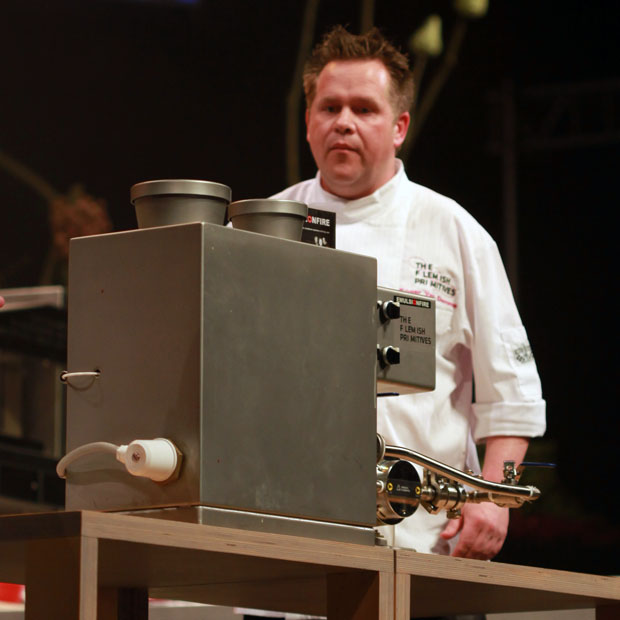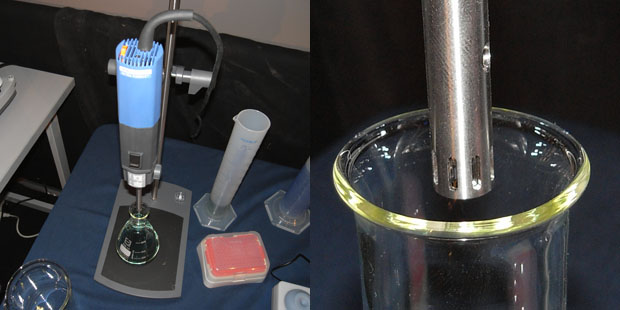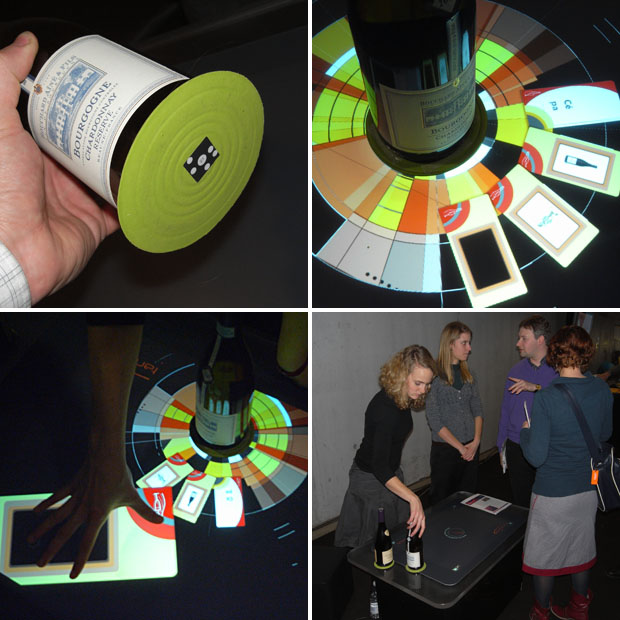
Crycotuv – a combined vacuum chamber and super fast freezer with internal spray nozzle.
If I were to name a topic for this year’s Flemish Primitives event I guess gadgets would be it. I’ve already covered the high pressure processing in a previous post. Regrettably we were only shown pictures and movies of this machine (it is to large/complex to be brought on stage) but there was much more that would qualify for a post focusing on some of the gadgets presented.
Crycotuv
The most obscure machine in my opinion was the Crycotuv – a vacuum chamber which could be cooled to any desired temperature between -150 and 0 °C in seconds/minutes. The rapid cooling was achieved by evaporation of liquid nitrogen (so in order to run a Crycotuv you’ll need a steady supply of LN2). The major benefit of rapid vacuum freezing is significantly less cell damage. In conventional freezing the damaged cells cause leaks when the food is thawed. When the desired vacuum was reached, a spray nozzle also allowed flavors to be sprayed onto foods inside the vacuum chamber, resulting in a “vacuum impregnation”. This was demonstrated with oranges slices which were submerged in coffee. Using the Crycotuv the airpockets were replaced by coffee.
(skip the long intro with overly dramatic music and view from 0:53 – that’s were the demo starts)
The most interesting demonstration was how one could use the vacuum to expand foods and then freeze them to obtain sponges. This was done with foie gras and I sure wish I could have tasted one of those! The Crycotuv is based on a ideas from Kristof Coppens and produced by Messer, and during the sessions the Jean-Claude Claeys and Harold Demoen (from Messer and Cretel respectively) were also on stage.
During the presentation is occured to me that the vacuum impregnation (without cooling) is identical to what you can do with the Gastrovac, and that you could even make a DIY version with a pressure cooker and a water suction pump. Or if you have a food saver with the possibility of attaching jars you can use them as well for vacuum impregnation.

Chef Roger van Damme with the EmulsionFire. Photo by Piet De Kersgieter.
EmulsionFire
An immersion blender will bring you quite far when making emulsions such as mayonnaise, but if you want to make emulsions at a larger scale the EmulsionFire could be your choice. The machine was demonstrated by chef Roger van Damme and 3 emulsion samples were handed out to every participant – they were indeed thick and very rich. In fact, it’s possible to make emulsions as thick as Nutella with EmulsionFire. It was mentioned that the machine uses magnets, but no details were given on this. My guess is that the machine uses a contact less, magnet based drive train in the emulsifier unit as would probably be qutie favorable from a cleaning viewpoint – but this is only a guess.

Samples prepared by the EmulsionFire: dark chocolate, milk chocolate and coconut creams.
Laboratory equipment
The large laboratory supplier VWR was a sponsor of the event and had a range of equipment on display at the back of the scene. I talked to the VWR sales representative Dominique Mauroy and he let me know that they soon will launch a brochure with laboratory equipment of particular relevance for use in the kitchen. I’ll update once I know more about this. There is also a launching event planned on April 19 in Belgium. Anyway – here are some of the gadgets VWR had on display. This is equipment that we use daily in my daytime job, and it’s really fun to see how it has found it’s way into kitchens.

To the left a conventional rotary evaporator, but check out the wide mouthed flask on the right! This is perfect glassware for food stuffs which are sticky and may require more extensive cleaning.

In chemistry labs UltraTurrax stirrers are a common sight. They are high shear stirres but without “external” moving parts (like the knives of an immersion blender) and are excellent for dispersion of hydrocolloids.

Freeze driers (left) are well known in the food industry, but chefs are also beginning to see the potential that lies in this low temperature flavor concentration technique. Of course there were also water baths for sous vide on display.

To the left a standard laboratory heating plate with magnetic stirring. To the right magnetic stirring bars of different sizes.
SOSA aroma library
SOSA should be well known to many with their extensive product range for professional kitchens. At The Flemish Primitives this year they displayed their aroma library. With a total of 192 flavors grouped into categories such as sweets, nuts, herbs, flowers, vegetables, roots, fiction, lactis etc you basically have “an alphabet of flavors” at your hands. It’s a great way of learning flavors and a perfect toolbox when investigating flavor pairings. I’d sure like to have a library like this in my kitchen! Interestingly Sense for taste (who formally run the foodpairing website) and SOSA had co-published a small booklet on flavorpairing with two recipes using some of the flavors from the “flavor alphabet”.

“Alphabet of flavors” from SOSA: 192 flavors at your finger tips!
Wine table
And finally a gadget for the more tech savy people: a Microsoft Surface table running a wine application (from the company Metanous). As you can see from the pictures and the video a coaster with an identifying chip is attached to each wine bottle. When the bottle is put down on the table it is immediately recognized and a circular menu appears around the bottle. If you move or rotate the bottle, the menu follows the movements. The menu gives access to text, pictures and videos about the wine, the grape variety, the growing region, interviews with the wine producers etc. The table allows plenty of simultaneous user interaction with different gestures and touches.

Due to the outbreak sessions I regrettably missed the presentation of Sergio Herman’s sophisticated dinner plates.
–
I also visited The Flemish Primitives in 2009. You can read more about that in my four posts from last year: The Flemish Primitives: A travel report (part 1), Chocolate surprise (part 2), Heston Blumenthal (part 3) and Glowing lollipops (part 4). Final note to readers: This year my travel expenses were covered by TFP and the tourism bureau of Brugge.

Wow! Interesting post 🙂
I have wondered if it would be possible to replicate the Gastrovac at home using a canning jar with vacuum sealer attachment in a temperature controlled water bath. The biggest issue would probably be maintaining low enough pressure while heating. Has anyone tried this?
Hot plate stirrers: I got a used hot plate stirrer on e-bay a while back to try cooking with. Its intended purpose, dissolving things in liquid while warming them, makes it ideal for dissolving gelatin and agar agar. It also works well for reducing liquids that like to boil over (like cream until it gets too thick). I experimented with using it for sous vide along with a PID controller, but haven’t been entirely successful yet. I may just use the stirring element and an immersion heater attached to the PID controller. Overall I haven’t found it as useful as I originally thought (I don’t reduce that much cream), but don’t plan to get rid of it either.